Title: Postwar Memory III
Dimensions: 11.2” x 15.9”
Statement
Postwar Memory is a series in which Tania Bruguera creates an independent newspaper as a work of art. It is one of the few documents in Cuban art scene reflecting the state of opinion during the most critical years of the “Special Period” in Cuba. Through texts and illustration on various topics including art, literature and culture, the artist invited the collaboration of many contemporary artist and critics who lived in Cuba and abroad. The paper reproduces the structure of Granma, the official newspaper-document of the Cuban Communist Party. Postwar Memory became a forum for the debate of non-authorized topics, criticism generally silenced by the state censorship on Cuban journalism. The Visual Arts Council demanded not to issue a second number. It was censored when it came out, part of the copies was seized to prevent their distribution and there was a threat of imposing an imprisonment sentence of up to 15 years. Police authorities discussed this event in some assemblies of the Cuban Communist Party. PostwarMemory was passed around and artistic and popular circuits made photocopies of it. The series is part of a research which intends to appropriate the tools used by power to offer a parallel reality. It has to do with the possibility of interweaving art with society in a hyperrealist way. In this case, Postwar Memory exists in a space where if functions as if it were an actual newspaper. It has been considered one of the first independent publications of those times and the first in which Cuban artists living within and without the island appear in the same space.
Postwar Memory III is made up of copies of a newspaper without name, dates or news. In their place there are political slogans that the Cuban revolution has used through the years and reproductions of some posters used in various revolutionary campaigns. The newspaper is an allegory of the inexistence of a journalistic exercise in Cuba, where national newspapers are based in a political discourse full of stereotypes and preconceived phrases establishing an ideological manipulation which answers the interests of the state and where there is no civic debate and social reality is not reflected. This issue of Postwar Memory comes out after a ten-year censorship, accompanying the individual exhibition of Autobiography (version inside Cuba) and as a newspaper distributed in Miami as part of the public projects of the Basel Art Fair.
Exhibited
| 2017 | |
|
Tania Bruguera: Talking to Power / Hablandole al Poder.Yerba Buena Center for the Arts. San Francisco, United States. Curated by Lucia Sanroman and Susie Kantor. June 16 – October 29 Publishing as an artistic tool. Kunsthalle Wien, Austria. Curated by Luca Lo Pinto November 8 – January 28 |
|
| 2010 | |
|
Tania Bruguera: On the political Imaginary(Survey Show). Neuberger Museum of Art, Purchase College, State University of New York. Purchase New York, United States. Curated by Helaine Posner. (catalog) January 28 – April 11 |
|
| 2004 | |
|
Art Projects. Art Basel, Miami. Curated by Rhona Hoffman Gallery. June 16 – 21 |
|
| 2003 | |
|
Autobiography. Museo Nacional de Bellas Artes. Havana, Cuba. Curated by Corina Matamoros. (newspaper) November 1 – December 15 |
Instead of just exhibiting Memoria de la Postguerra [Postwar Memory] in a cultural institution, the idea was that it would move within the city, that it would go from hand to hand and that the circulation of this material would be known through rumor.
Documentation
Access DOWNLOAD to read the Edition III of Postwar Memory
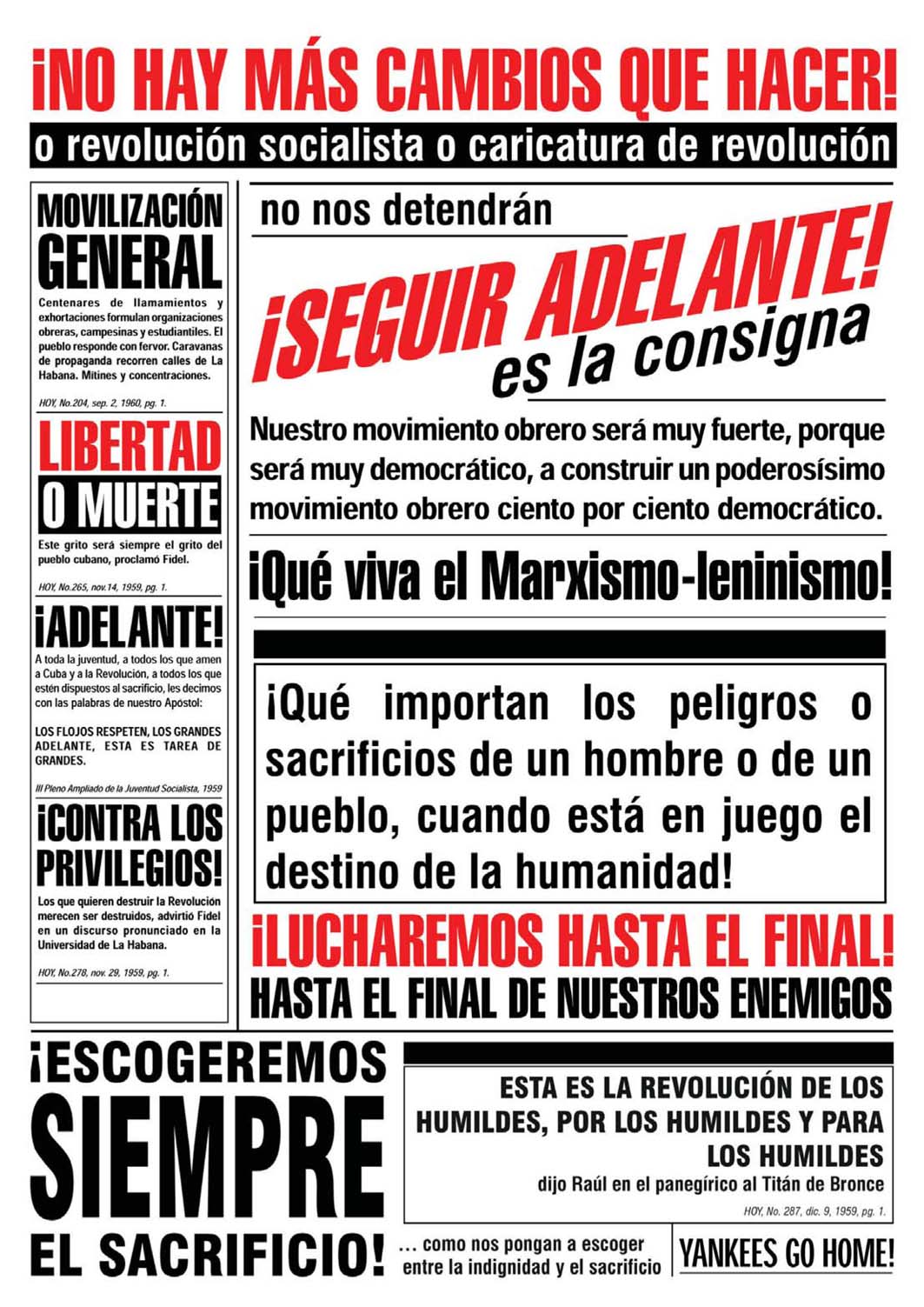 |
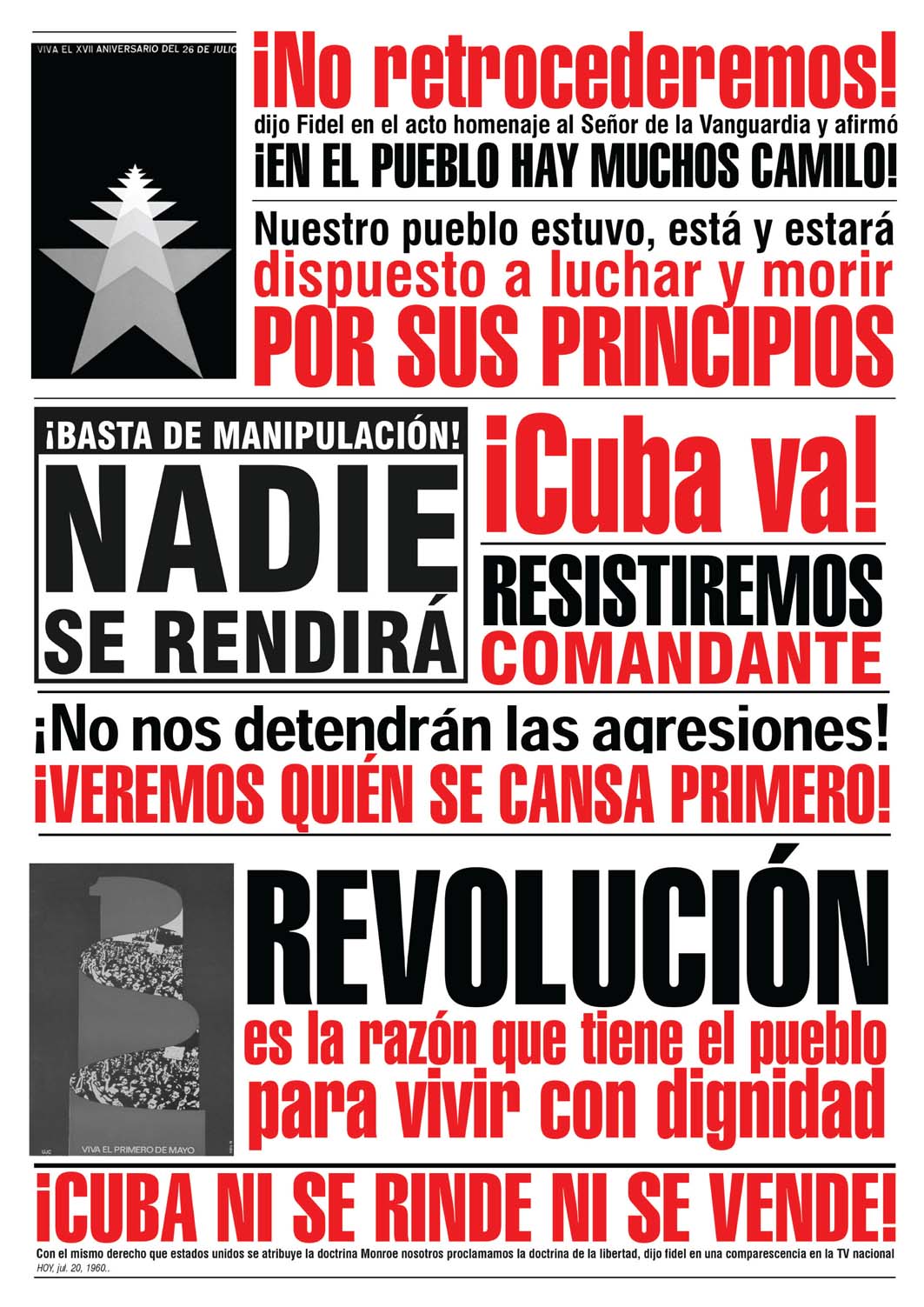 |
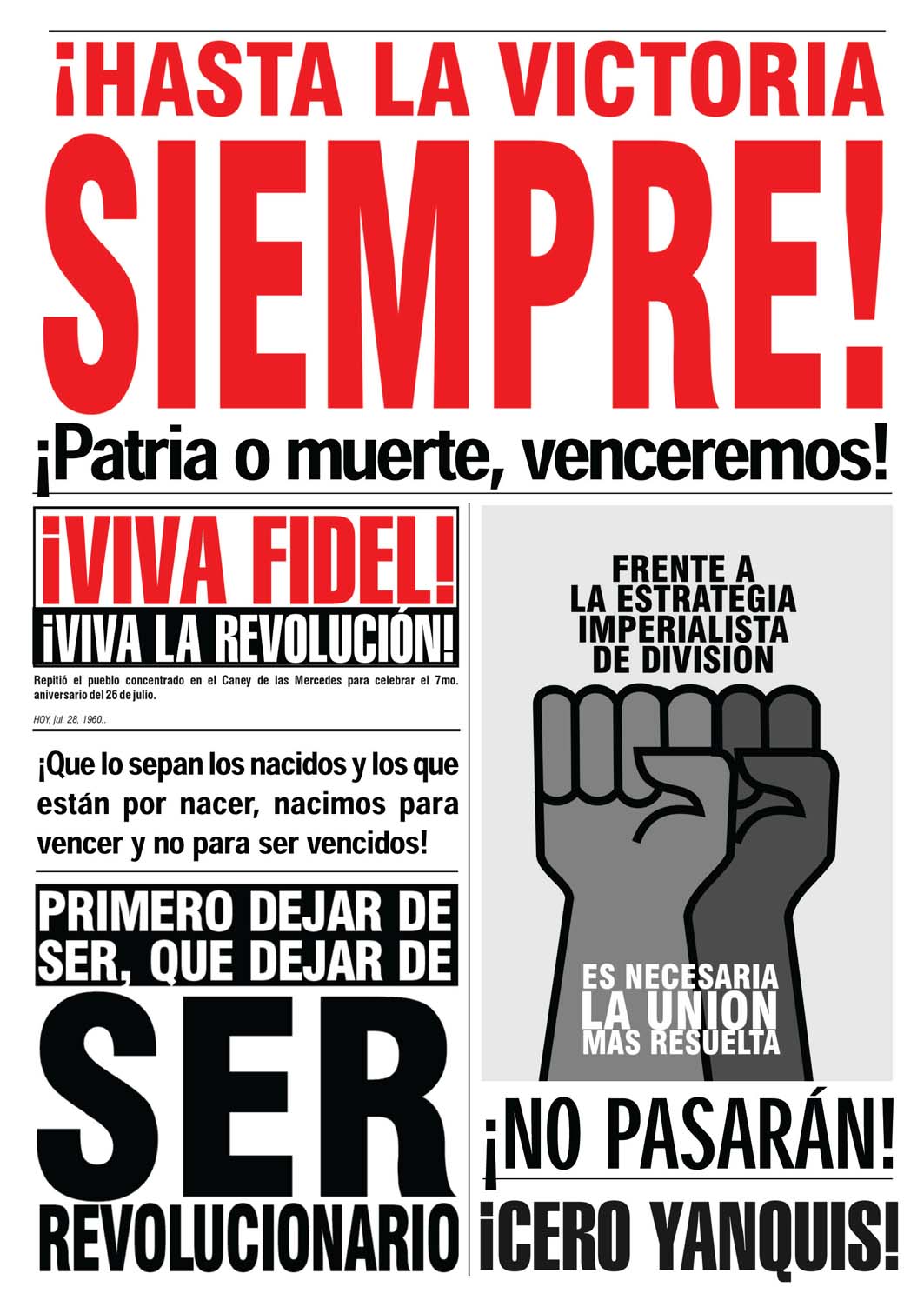 |
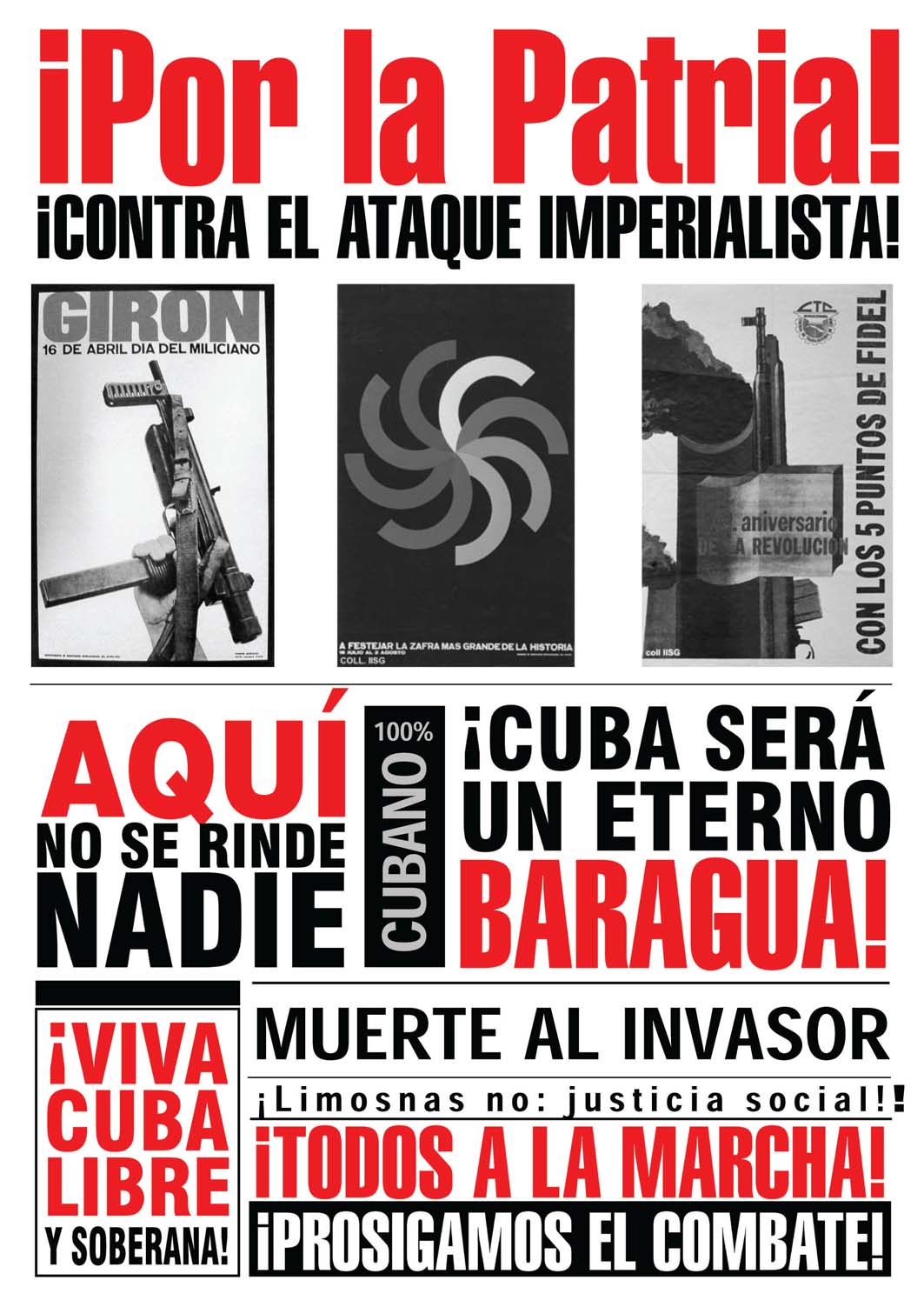 |
|||
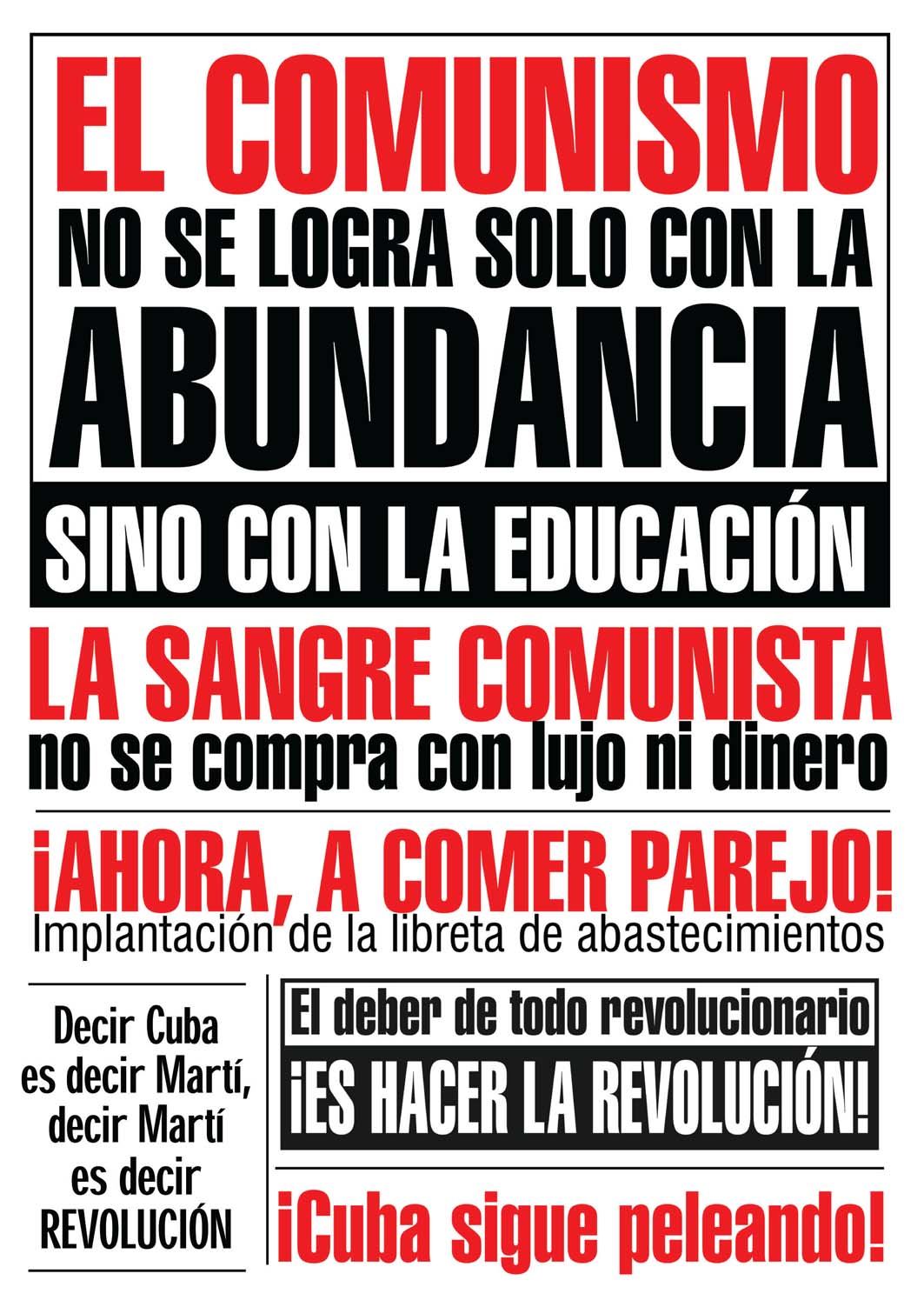 |
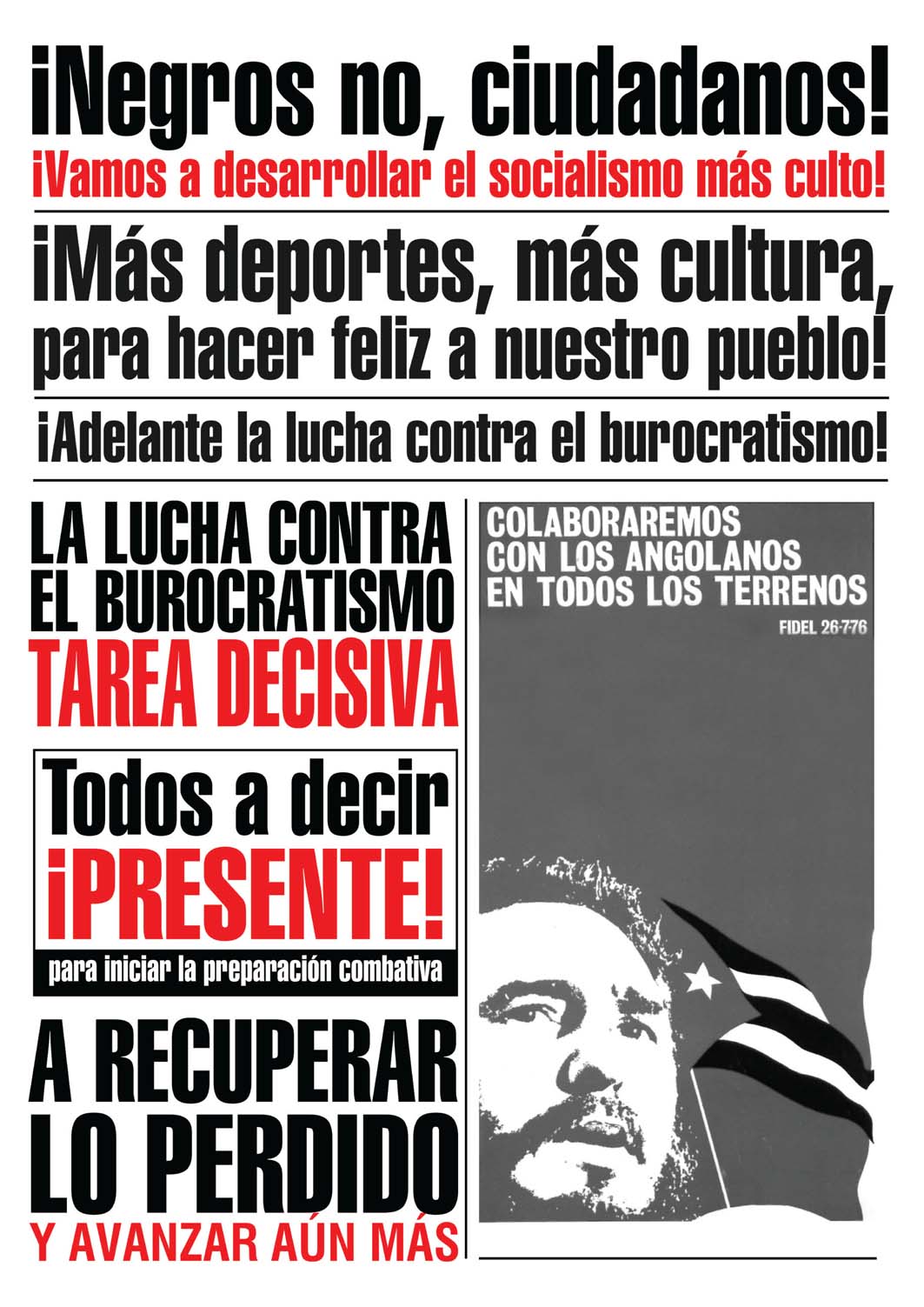 |
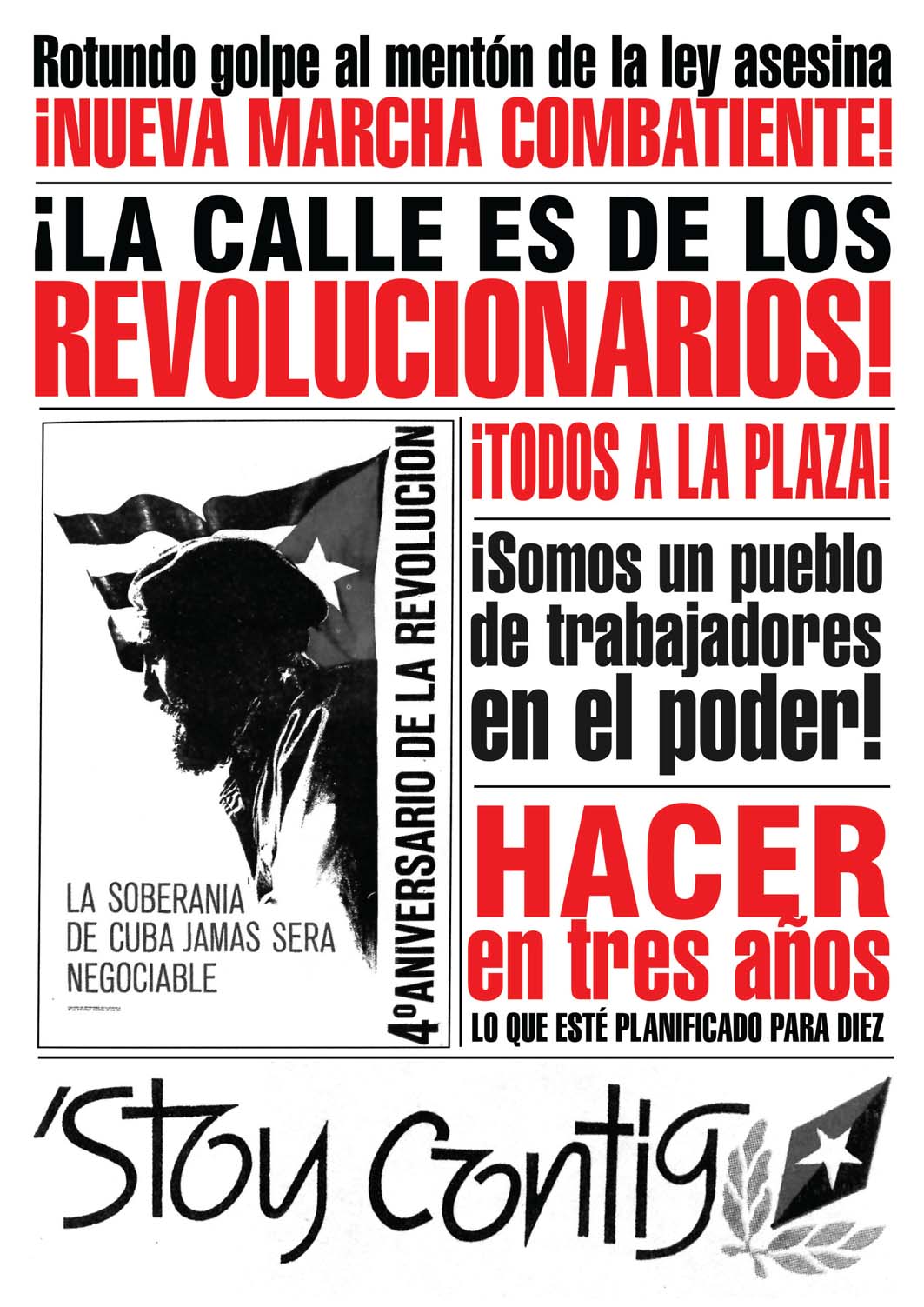 |
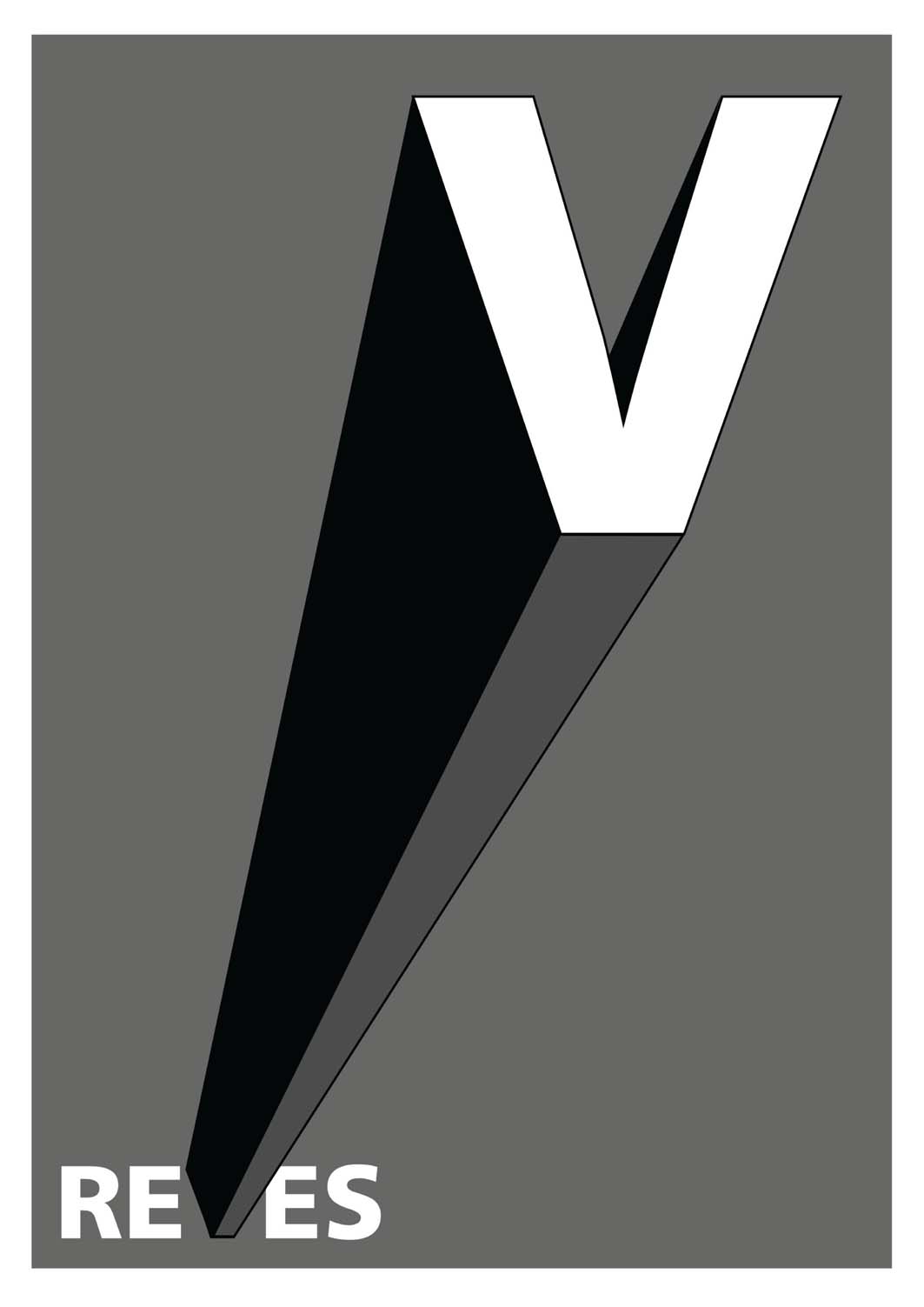 |
Photos courtesy of Studio Bruguera and MoMA Artists Books collection
Selected bibliography
(by alphabetical order)
Birringer, Johannes “Art in America (the dream),” Performance Research Journal, Volume 3.1, 1998. Ed. Routledge, London, England, (illust.) pp. 24 – 31. ISBN 0415182018.
Bruguera, Tania “Postwar Memories,” By Heart / De Memoria -Cuban women’s journeys in and out of exile-, Edited by María de los Ángeles Torres, Texts by various authors, Ed. Temple University Press, Philadelphia, United States, 2003, (illust.) pp. 169 – 189. ISBN 1-59213-010-0
_______________ “Tania Bruguera,” UnDo.Net, La Generazione delle Immagini, vol. 7 – 2000/01 – Racconti d’ Identitá. Milano, Italia.
Camnitzer, Luis “Memory of Postwar,” Art Nexus, no. 15, Jan-March, Bogotá, Colombia,1995, p. 30.
Cippitelli, Lucrezia “To put an end to aesthetic judgements. Life, useful art, civil society and the diasporic gaze,” Tania Bruguera, On the occasion of the solo show “Giordano Bruno for Saint,” MLAC – Museo Laboratorio Di Arte Contemporanea, Roma, Italy. Ed. Postmedia Srl. Fiesola, Italy, November 2010, (cover & illust.) pp. 16 – 31. ISBN 88-7490-051-0
Creehan, Jessie “Tania Bruguera or performance as a means of reflection,” Travel and Leisure, Centro Risorse. Madrid 2006.
Donovan, Tom “5 Questions (for Contemporary Practice) with Tania Bruguera,” Art:21-Art in the Twenty-First Century Blog, April 14, 2011, New York, United States.
Fadraga Tudela, Lillebit “Fragmentaciones y otros vicios secretos en la obra de Tania Bruguera,” La Gaceta de Cuba, no.6, Nov.-Dic., Havana, Cuba, 2000. (illust.) pp. 41 – 43.
Farber, Howard/Patricia “Tania Bruguera“, Farber Collection, Bio for Cuba Avant-Garde, contemporary Cuban Art.
Fernandes, Sujatha“Postwar Reconstructions,Cuban Public Art and the Making of Transnational Communities,” Prepared for delivery at the 2004 Meeting of the Latin American Studies Association, Las Vegas, Nevada, October 7 – 9, 2004.
Goldberg, RoseLee “TANIA BRUGUERA,” Mayo 2005, pp. 218″¨ISBN 0-9769449-0-1. On the occasion of Prince Claus Fund award and “The experience of Art.” International Art Exhibition, Padiglione Italia 51 Bienale di Venezia.
Howe, Linda S. “Transgression and conformity: CUBAN writers and artist after the Revolution,” The University of Wisconsin Press. pp. 50, 53, 65. ISBN 0-299-19730-1
Lambert-Beatty, Carrie “Political People: Notes on Arte de Conducta,” Tania Bruguera:On the political imaginary, Ed. Charta, Milano, Italy, 2009, (cover & illust.) pp. 37 – 45. ISBN 978-88-8158-764-3
Molina, Juan Antonio “Entre la ida y el regreso: La experiencia del otro en la memoria,” 23 Bienal de Sao Paulo (Brochure), Consejo de las Artes Plásticas, La Habana, Cuba, 1996 (illust.) pp. 1 – 4. / Revista de arte Cubano, Ruta Crítica. No. 1/1997. (illust.) pp. 68 – 70.
Muñoz, José “Performing Greater Cuba: Tania Bruguera and The Burden of Guilt,” Holy Terrors: Latin American Women Perform, Edited by Diana Taylor and Roselyn Constantino, Various authors, Ed.Duke University Press / Tisch, United States, 2003, (illust.) pp. 401 – 415. ISBN 0-8223-3227-2, ISBN 0-8223-3240-X
Pinto, Roberto “Exercise in resistance [Esercizio di Resistenzi],” Ed. Galeria Soffiantino, Turin, Italy, 2003, (illust.) pp. 1 – 80.
Sosa Fernández, Sandra “Acotación“, The H Magazine.
Villalonga, Yuneisky “Tania Bruguera; Her Place an Her Moment. Maintenant, Ici, La-Bas [Now, Here, Over There],” Frac Lorraine. 2007 (illust.) pp.74 – 95. ISBN 978-2-911271-11-3
Zaya, Octavio “Against the Forms of Power,” Culture and The Human Body, Prince Claus Awards 2008, (illust.) pp. 46 – 49.
Quotes
(by chronological order)
Under this title-dripping with fresh pain or blood -a new publication has appeared in Cuba. Half-way between an art journal and a newspaper- not in terms of its presentation, which is economic and textual, but at the conceptual level, Memoria is an unusual event in the cultural life of Cuba of the last decade, with an outstanding presentation at the recent fifth edition of the Havana Biennial, is the creator and director of the publication, the first issue of which was distributed at her installation at the Biennial. The publication is self-financed and gathers together ideas by artist and critics who want to express their views. Neither of these features suffices to describe the journal. What is noteworthy is the fact that at a time of unprecedented economic crisis in which distances have grown almost ad infinitum due to the lack of transport and the international dispersion of artist, Memoria has not only assembled ideas but has helped maintain a sense of coherence.
Luis Camnitzer. “Memoria de la Postguerra,” Art Nexus, no. 15, Jan-March, Bogotá, Colombia, 1995
“…that is why Memoria de la Postguerra is not a frustrated work, but simply a work that includes frustration among its functional premises. The name of the newspaper covers the entire Tania’s esthetics. Her work has constantly been a remembrance of something, an evocation presented as a creative process. The importance she grants to performances as the structure of her work has to do with considering art a process and not a result materialized in an object, but the course through which something transcends itself. Objects are concentrated in time more than in space…”
Juan Antonio Molina. “Entre la ida y el regreso: La experiencia del otro en la memoria”, 23 Biennial of Sao Paulo (Brochure), Havana, Cuba, 1996
Memory of Postwar, apart from being a periodical, was a gesture intended to give cohesion to the generation of the ’90s and rescue a universe of debate and social commitment in art that although it was never completely lost, was beginning to appear in a much more concealed way. This gesture implied the emergence of a new communication channel among the artists themselves (the periodical) and between them and the audience. It is also important to point out that, in the original project, the first number was to be handed out by the artist herself in the inauguration of an individual exhibition with the same name in the Plaza Vieja Gallery in 1993. There Tania intended to embody a person handing out fliers or some type of propaganda (the term advertising was not too popular at the time) which fitted very well with the general idea of the sample: the paths of art in a stage of violent changes, of imminent dollarization and the need to foster spaces to channel the creators’ concerns.
Lillebit Fadraga Tudela. “Fragmentations and Other Secret Vices in Tania Bruguera’s Work,” La Gaceta de Cuba, no.6, Nov.-Dec., Havana, Cuba, 2000.
“…Memorias de la Postguerra was an entirely self-financing publication in which cultural issues were interwoven with political debate, highlighting positions and supporting trends that were decidedly anti-government. In this magazine Tania Bruguera collected the ideas and interventions of Cuban artists and critics that oscillated between seriousness and ferocious irony. Above all, though, Memorias de la Postguerra was an important vehicle that connected two generations of Cuban intellectuals which, while only separated by a few years difference, found themselves having to make very different choices: almost all the artists slightly older than Tania Bruguera, Carlos Garaicoa, Los Carpinteros, Kcho – who all remained in the Isla – were virtually obliged to emigrate in order to fill the information gap and especially to find that freedom of expression that had not existed under the last years of Castro’s Cuban flag. Memorias de la Postguerra succumbed after only two numbers, naturally not because of financial problems.”
Roberto Pinto. “Exercise in resistance [Esercizio di Resistenzia],” Ed. Galeria Soffiantino, Turin, Italy, 2003
“…Bruguera’s journal/newspaper, Memorias de la Postguerra, at this point was censored by the state. Each body becomes a colonized territory. But certainly other meanings can be deciphered if we attempt to understand the affective dimension of the performance. The art world denizens are conquered by an imperial specter. In the highly metaphoric field of Greater Cuba, this scene can potentially be read as depicting the colonizing force of the United States, Miami, or Castro, depending on one’s particular ideological position. But that aspect is left open. The work does not target any one culprit; it is instead interested in unpacking a particular affective scene. Her work is a study of the ways in which Cubans are confronted by colonizing exterior force…”
José Muñoz. “Performing Greater Cuba: Tania Bruguera and The Burden of Guilt,” Holy Terrors: Latin American Women Perform, Edited by Diana Taylor and Roselyn Constantino, United States, 2003
“…In 1993, the artist commenced Memoria de la Postguerra [Memory of the Postwar]. The series is one of the few documents that reflects the state of opinion within the art scene during the most critical years of the ‘Special Period’ on the island.17 Aesthetically and in mood, Havana was then post-war apocalyptic, and Bruguera decided to launch an alternative newspaper, to which she invited many contemporary artists and critics living in Cuba and outside to contribute texts and illustrations. Its issues (with the visuality and quality of the official document/paper of the Cuban Communist Party, Granma) reflect the shift in perspective. A single generational consciousness comments ‘from inside’ and ‘from outside’. With the transcendentalist accent of the editorial discourse of Granma, the artist comments: ‘Beyond the vast utopias, on the real plane of the efficiency of art, only CULTURE exists, with the analytical consciousness painfully preoccupied with dialogue […]; with the capacity to remember and to situate once more…”
Yuneisky Villalonga. “Tania Bruguera; Her Place an Her Moment. Maintenant, Ici, La-Bas [Now, Here, Over There],” Frac Lorraine. 2007
“…where Bruguera borrowed from a legend of the Cuban war of independence to project a desperate plea for freedom trough suicide, belongs to her first series of performances, know as the Memorias de la Postguerra (Memories of the Postwar)…”
Zaya, Octavio. “Against the Forms of Power,” Culture and The Human Body, Prince Claus Awards 2008
“…Memoria de la postguerra as an underground newspaper that collected work from across the diaspora, and its unpublishable compendium concluded with a list of 106 Cuban artists whos had left. Memoria embodied the camaraderie -protective, jumpy, benighted, and blasphemous as ever- of the new, chastened present. But for all of Bruguera’s mournful introductory tone (‘Postwar,’ for its resemblance to the physical condition of the city, the interior state of the people, the social nature of art,” read the front-page editorial), the paper was marked by a strange mixture of torment and silliness. With its ambiguous logo (the Kettering either the work of a rushed street graffitist or else a victim’s last words, dripping in blood), mock promotional campaigns (matching plastic ashtrays), articles with a dubiously journalistic gloss and news from the front, Memoria was a difficult work to parse, roving among mourning and malice, anguish, and disdain. Ceballos caught the mood with her Psychiatric Exam of a Post-War Artist, diagnosing “a noteworthy collapse of the upper cranial area” because of “an excess of cognitive information. Long period exhibited at work on theoretical Works and torced concepts,” and prescribing “five or six months of rest in the Swiss Alps, or in Cayo Largo” as the cure.The war was over, and Memoria was at the press conference, held at “the Center for the Salvation of Plastic Arts, in the capital.” A painter confirmed the rumors, Rafael López Ramos reported, “Although an armistice has not been signed.”Among these photostatic documents was not Licking and image of the members of the distinguished Ditch Diggers and the Laboratory of Anthropological Armaments working in the Eastern village of Pilón, nor of the Section of Projects of Social-Military Insertion, who today have bases in some city in Venezuela or travel ubiquitously around various countries in Latin America. Asked by this reporter about the possibility of a rejoining off forces by the army known in bygone days as Young Art, he responded with a la laconic “No comment…”The question that the artist could not answer precisely was the one regarding the Exchange of prisoners and the repatriation of war refugees who remain for the most part in Camps supervised by the UN in Mexico and US. Nonetheless, he announced that the matter would be discussed in a meeting attended by both parties at the Prado Museum, neutral territory offered by the Spanish Ministry of Culture. Memoria de la postguerra was proof: solid, concrete Proof of everything that was in danger of evanescing. And, with that squarely on the table, it kept returning to the question, what next? Rejoining forces? “I do not know to what extent or with what views the ranks will again restructure themselves,” Bruguera wrote, “A new army advances, along with the survivors, with the given lessons of history, exhausted and alert in other areas, all youth grown violently old. And the latent need, awaiting, again dressed as a Bride at the gates of legitimacy still with transcendental hardships…. Will we again wait another decade for the forge? Will we again stay by the side of the road, maimed and resigned? Will we again hope to relieve ourselves the center of the World at the wrong moment? Do we have enough time left? These are the fifteen minutes that again have been our lot.” The first issue of Memoria came out in November 1993, in the depths of the Special Period. The second issue was published in June 1994, if anything an even worse moment. It hit a nerve: its compendium of bitterness, nostalgia and mockery revolving, more or less, around the theme of migration (including a snapshot of two jubilant balseros) was apparently too much. The paper was censored before it could be distributed, its editorial team was subjected to treats and intimidation (one of them was detained), and that was the end of it. The work had succeeded in the eternal artistic goal of exceeding its own limits: it had “entered the larger society, not as an artwork but as an event,” and that had been its downfall…”
Rachel Weiss. “The Organizing Past,” To and From Utopia in the New Cuban Art, Ed. University of Minnesota Press, 201